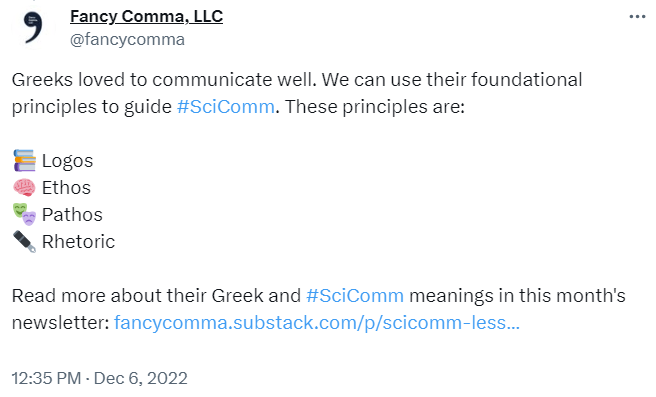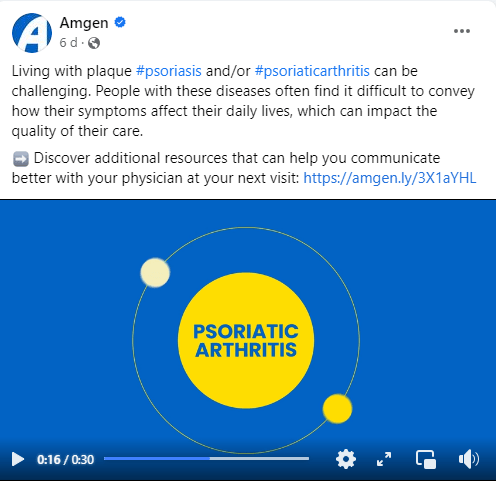Make “better living through science” happen! Science copywriters combine #SciComm and marketing strategies to dazzle everyday consumers while improving science literacy. Learn science copywriting for Facebook and Instagram in our guide.
Tweet
In this blog, guest contributor Apara Timileyin provides tips for science copywriters writing social media copy – namely, for Facebook and Instagram. Keep reading to learn more!
Wait…what is science copywriting, again?
In the marketing world, written text, such as a written ad or an email used in a marketing campaign, is known as “copy.” Marketing writers are therefore known as “copywriters.” Fancy Comma does science copywriting for different clients, but we also train scientists to communicate better.
Did you know that you, too, can work in communications and marketing as a trained scientist? You can write blogs, social media posts, and more. Here are 10 forms of SciComm that SciCommers can also use in the marketing world.
Your job as a science copywriter could be writing science-informed social media posts for various organizations, such as biotech companies! Even if you’re a scientist and don’t want to make a living out of science copywriting, learning science copywriting basics can help you level up in your SciComm endeavors.
Science copywriting for the Metaverse
Picture this: A medium that helps you unpack the complexity of science, making it digestible for not only the folks in the science community, but the general public as well. Thanks to this medium, consumers achieve better living through science through marketing that adheres to SciComm principles.
One cool real-life, public-facing application of science communication is writing tweets, Facebook posts, and other social media content. As a science communicator, your skills transfer readily to the world of science copywriting. Science copywriters can tailor messages to resonate with the audience and address their needs, while also ensuring that the science is explained well, helping improve science literacy and curbing misinformation. Yes, you can get paid to come up with social media content. If you already spend a lot of time on social media and love to explain science, it may not even feel like work.
As a marketer writing social media content, you are essentially a source of public-facing science information. The scope of science copywriting extends beyond research papers, website content, and press releases. It extends into social media, helping science communicators expand their reach and share their expertise with a wider audience.
Science copywriting on social media can help establish awareness of a medical condition or scientific findings, products, and/or services. As an example, check out Pfizer’s Instagram post about clinical trials for a disease called multiple myeloma: a cancer of white blood cells that currently has no cure, only lifelong management.

In this Instagram post, Pfizer raises awareness that the condition is not the end of the world, and that people with it can have a normal life. Furthermore, beyond the Instagram ad, one can travel to their Instagram link-in-bio to read more about multiple myeloma. You may ask: why is this content important? Pfizer is a research and development company working on highly specialized biomedical science and technology. Their research areas and products make sense to their scientists, but require some explanation to the outside world.
People beyond the everyday person curious about multiple myeloma can also benefit from this social media content: lawmakers, patient advocates, people with loved ones suffering from the disease, and others. This post is also archived in Google Search and can be a source of information there later.
Science copywriting can be applied on platforms like Facebook, Instagram, LinkedIn, Twitter, and Google ads. This article will focus on writing science copy for the social media sites Facebook & Instagram. Subscribe to the Fancy Comma blog so you don’t miss helpful science copywriting tips.
Science Copywriting for Facebook & Instagram
The same parent company, Meta, owns Facebook and Instagram. These two platforms have amassed billions of users across different demographics for almost a decade.
The best part? With seasoned science copy, Facebook and Instagram can be used to educate, inform, and persuade your audience to take action that changes their lives.
Are you on the verge of scientific discoveries?
Working on a life-changing thesis as an undergraduate or graduate student?
Perhaps you have new evidence to discredit or reinforce existing findings?
Science copywriting could be the holy grail that helps get your message to the right people. Below, you will learn:
- How to structure science copywriting for Facebook & Instagram
- Some of the best practices for social media science copywriting on these sites
- Common mistakes you should avoid when writing your copy
How to Structure Science Copywriting for Facebook & Instagram
It’s important to know your audience before you craft those persuasive words that evolve the right emotions in your audience. To sell an idea, product, or service, you must clearly understand what your audience wants. A great way to know your market is by conducting customer research into your target audience. Ask yourself: who will be reading this content? What do they want to read?
Once you’re done answering that question, the next phase is to tailor your science copywriting for Facebook & Instagram. You’ll need to write a text post or “description” whether for Facebook or Instagram. Make sure to include a call to action to get people to do what you want them to do, and use the right hashtags so people can find your post more easily.
Here’s how to do it:
Writing the Text Description
Facebook and Instagram descriptions are the text that your audience will see when your post pops up on their timeline. Remember that they’re just scrolling by, so keeping it brief and snappy can help attract attention and, yes, likes and shares. Make sure you include the important stuff: copy that speaks to your audience’s challenges, as well as ways that your product, research findings, and/or services can improve your readers’ lives.
SciComm knowledge helps a lot here. Don’t forget to keep your copy lively by using analogies and metaphors relatable to readers’ day-to-day lives.
Call To Action (CTA)
The next thing, after coming up with the description, is to direct readers to take action. That could be to read your new blog, buy your product, or even read a report about your findings.
Copywriters, including science copywriters, use a call-to-action or CTA to direct readers to act. That could be to read your new blog, buy your product, or even read a report about your findings. The CTA is technically part of the description, also, but you will want to spend time working on it specifically.
Make sure that your CTA achieves the tone you want and persuades your readers to perform the desired action, whether it’s to click a link, buy something, follow you on social media, or something else.
Use Hashtags
Lastly, using hashtags can help you increase engagement and brand strength. It can also help you attract prospects and new followers. Although hashtags are less popular on Facebook, they are more effective on social media platforms and Instagram.
However, don’t just use random hashtags. Spend some time on Twitter and Instagram to see what the top hashtags are for your content area. Doing your research will help you generate the right hashtags for your marketing strategy – ones that work to boost engagement, get new followers, and amplify your posts.
Best Practices for Science Copywriting for Facebook & Instagram
Use a tried-and-true copywriting formula
Over the years, copywriters have come up with tried-and-true formulas that can help simplify the writing process. Science writers can learn these and adapt them to their needs. If you are a science communicator, learning copywriting techniques can help you become a science copywriter or just a more effective and persuasive writer.
Two well-known and simple formulas for copywriting are abbreviated AIDA and PAS. AIDA stands for Attention, Interest, Desire, Action. Read my blog explaining AIDA here.
The other format, PAS, stands for Problem—Agitation—Solution. Next, I will discuss this model and how it can help you in social media science copywriting. I will also provide an example of PAS in action in the biomedical copywriting world.
Let’s get to it.
Problem: Start by identifying your audience’s problems upfront. Are there controversies and ethical dilemmas that need to be addressed? Perhaps you need to engage the policymakers in your country to influence policy choices that affect lives.
First, you need to do thorough research to understand your audience’s challenges. Can you create science copy that resonates with your target audience?
For example, let’s say you are selling a new product for treating acne that is free of side effect causing ingredients like benzoyl peroxide, salicylic acid, or retinoids.
Acne can cause poor self-image, low self-esteem, and anxiety. Science copywriters in the skincare and beauty realms should highlight these issues and make their audience aware of the potential consequences if they don’t take action.
Agitation: Unfortunately, many copywriters identify the problems and dive right into the solution—skipping the agitation step. Because of that, the copy fails to connect with the audience and move them to take action.
You’ve only made them aware of their problems, and now it’s time to agitate your audience so they can get the full picture of the situation.
However, don’t appear desperate to make sales, commanding and needy. The whole point of agitating them with your copy is to help them see that the problem is worth solving.
Let’s come back to our acne example. Acne is a skin condition that can lead to inflammation (swelling, redness, heat, and pain). If you feel that won’t be enough to get them to listen, you can highlight other medical conditions associated with acne. Here are a few questions you can ask yourself to help get started:
- What is the common misconception about the problem?
- Why does the problem exist?
- What are people losing or lacking because of the problem?
Solution: Finally, you need to unveil the solution to the problem. At this stage, you present your products and services as a solution to the identified problems. You also should talk about ways your products and services solve their specific challenges.
Don’t bombard readers with non-related features of your products and services. Instead, focus on the immediate benefits to your audience.
Amgen is a global biopharmaceutical company that discovers medicinal solutions for patients with serious illnesses. Here, we will analyze one of its Facebook posts on psoriasis in the context of the PAS copywriting technique.
- Problem: Living with plaques #Psoriasis, and/or #Psoriatic arthritis can be challenging.
- Agitation: People with these diseases often find it difficult to convey how these symptoms affect their daily lives, which impacts the quality of their care.
- Solution: Discover additional resources that can help you communicate better with your physician at your next visit: https://amgen.ly/3X1aYHL
The PAS formula is simple but effective. You can also use it with more complex science communications. Try it out!
Include social proof
Social proof refers to the phenomenon in which people copy others’ actions to behave in a socially acceptable manner. The basic idea of social proof is that seeing is believing. Social proof can be used to point out the number of customers you’ve satisfied.
When you include social proof in your copy, the audience sees evidence that others have firsthand experience with your products and/or services and consider them valuable or helpful. Social proof could take the form of testimonials, reviews, case studies, and/or endorsements from an expert in your industry.
Visuals are everything
Using visuals alongside your copy helps pique your audience’s interest. Humans process images way faster than text. Including images makes your content more visually interesting, which means more people will interact with your content. That’s always great news!
Remember that the visuals you use must relate to your copy. Also, the visuals should be of high quality and elicit human emotions that go well with your copy. Here are some visual ideas you can explore for your science social media postings:
- User-generated content or UGC: This could be a short video of previous clients describing their experience with your product/services, or selfies of people sharing their experiences with your product. UGC is a perfect example of social proof.
- Images and photos
- Infographics
- GIFs and memes
- Short videos
Add Emojis
You are probably skeptical of using emojis in your Facebook and Instagram captions because they are witty and unserious. Don’t be afraid to use emojis on social media!
When used correctly, emojis grab attention and make your content stand out with the right “feels.” They can be used to communicate human emotions such as fear, excitement, fun, and more.
The best way to use them is before and after text; this helps break your text up so it’s easier to read. You can also use them as bullet points, as Fancy Comma does in their tweets!

Things to Avoid
There you have it. Now that I’ve walked you through some of the best practices in science copywriting for Facebook & Instagram, here is what you should avoid:
- Lack of understanding of your audience and their challenges
- Prioritizing sales instead of solving your audience’s problems
- A non-strategic approach to posting on Facebook and Instagram
- Being too formal instead of having a relaxed and friendly tone
- Absence of a call-to-action that nudges the audience to act
Final Thoughts
Using science copywriting principles for social media doesn’t have to be only for marketers. You can use the above insights as a scientist on social media, whether you are posting about your latest paper or just sharing some interesting insights. Facebook and Instagram can be great SciComm platforms for scientists and marketers alike!
Make sure to subscribe to the Fancy Comma blog for more insights on communicating science effectively, and follow Fancy Comma on Instagram and Facebook, too.

About Apara Timileyin
Apara Timileyin writes copy and engaging content for business-to-business (B2B) and business-to-consumer (B2C) companies. If he’s not writing, you’ll find him in front of movies or anime screens, reading a book, listening to his favorite songs or taking landscape pictures. Check out Fancy Comma’s interview with him here. He can be reached on Twitter @AparaTimileyin and on Instagram @the_timii.
